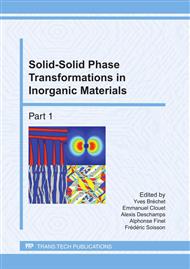p.893
p.899
p.905
p.911
p.916
p.922
p.931
p.941
p.947
Phase Transformations on Friction Welding of Dissimilar Thermochemically Treated Steels
Abstract:
The friction welding process provides a continuity of the joined materials at crystalline network level. This continuity is based on diffusion phenomena, on the forces of inter-atomic links as well as on the thermal and mechanical energy inputs. The action of the thermo-deformational field developed during the welding process is associated with solid phase transformations, influenced in terms of nature and intensity by the sensibility to mechanical hardening of the steel components, the critical quenching rate and the re-crystallization temperatures. The composition and microstructural gradients of thermochemically treated steels by carburization and nitriding leads to particularities in the morphology of the transformations induced in the welding plane. The work reports on the transformations observed in the joining plane explored by microstructural, hardness and impact testing.
Info:
Periodical:
Pages:
916-921
Citation:
Online since:
June 2011
Authors:
Price:
Сopyright:
© 2011 Trans Tech Publications Ltd. All Rights Reserved
Share:
Citation:


